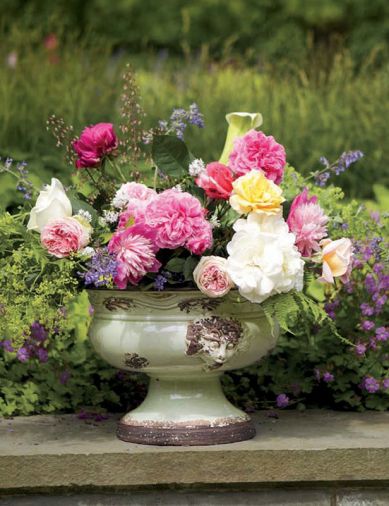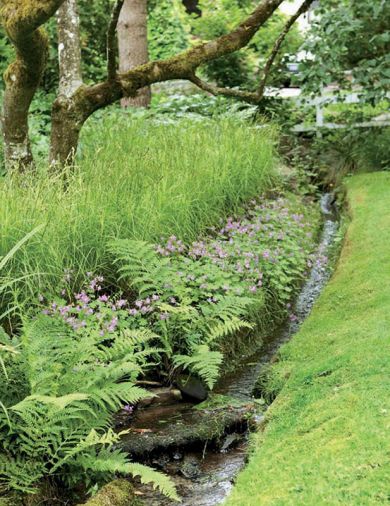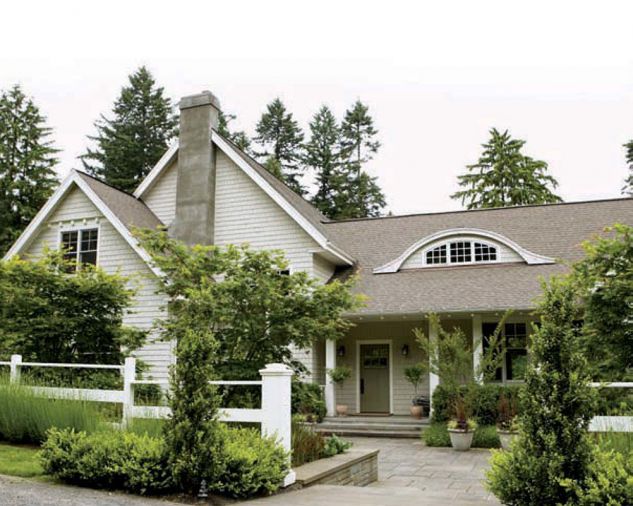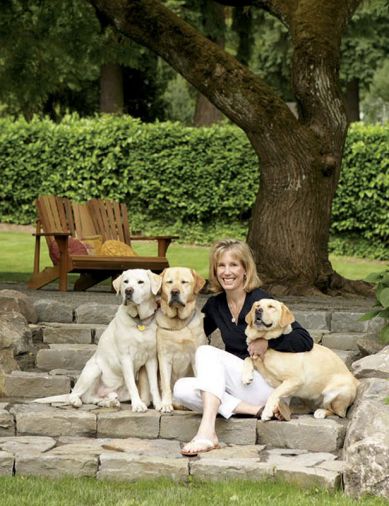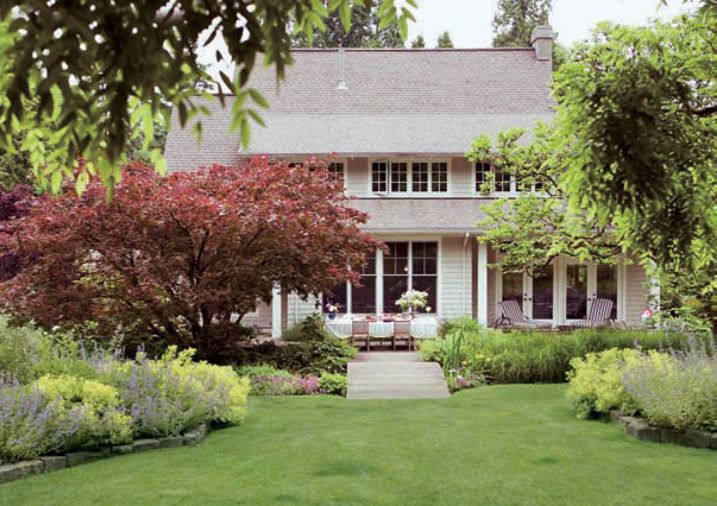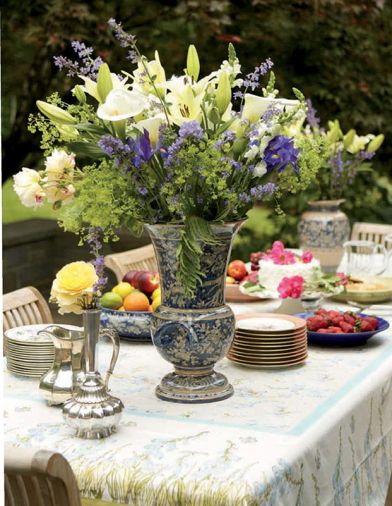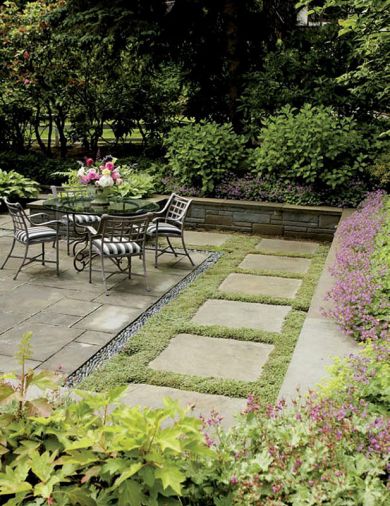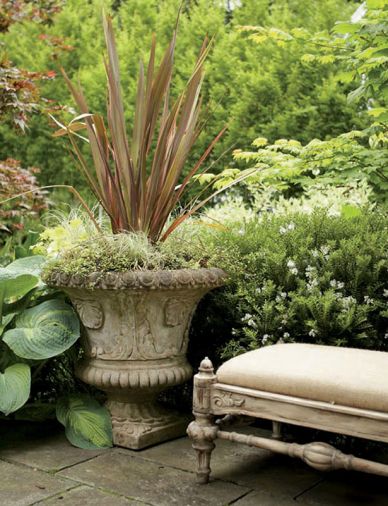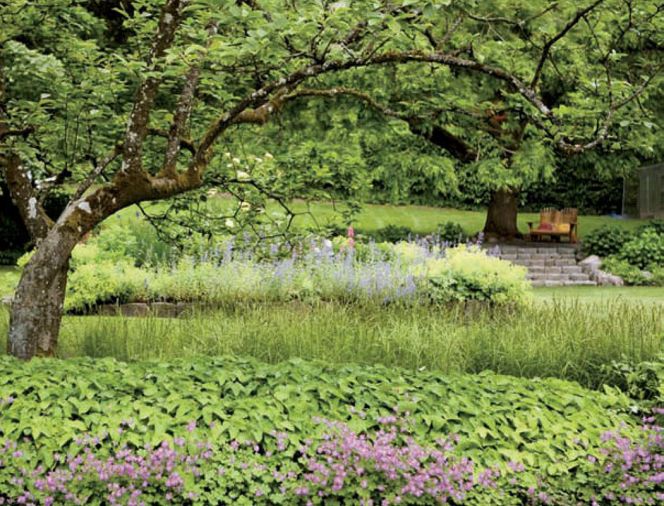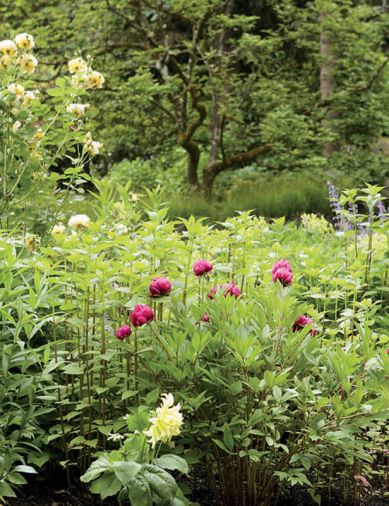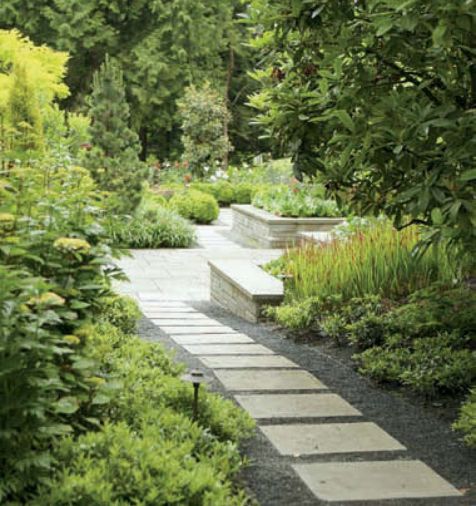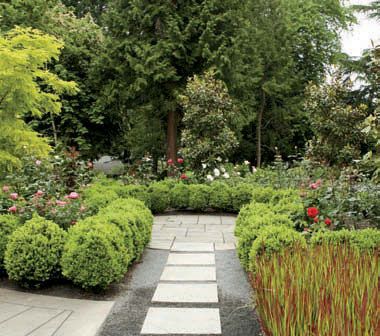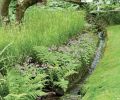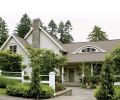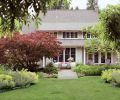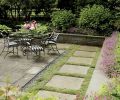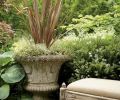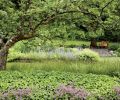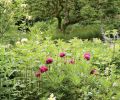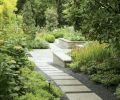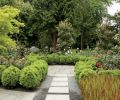When Elizabeth (Liz) and Nick Williams designed their home, which was built over 2001-2002, they wanted a house that would immediately look old and well-loved. That they have so beautifully succeeded is, in part, testimony to the evocative style of the house, which nods to both England and New England, and also the creative partnership Liz has forged with Portland-area landscape designer Michael Schultz. The house sits on a slightly less than one acre lot, on a visible corner of the Riverdale area in Dunthorpe. The surrounding garden had to provide more privacy while still presenting a welcoming face.
The previous owner of the property was a past-president of the Portland Rose Society who maintained a large and decidedly non-organic rose garden. Liz is an avid and lifelong gardener, and started this garden by scaling back the quantity of roses, removing some of the other plant oddities, and inviting Michael into her garden-making process when problems of elevation, and dealing with the local seeps and artesian wells on the site and in the neighborhood required professional assistance.
Unlike some of Michael’s clients, Liz and husband Nick are hands-on gardeners with a deep love of plants and grow.ing things. They revel in the tasks that make a garden, and so, in this case, Michael did not have the onus of providing a “low-maintenance” planting plan. Michael is known as a keen problem solver used to working with an innovative palette of hardscaping materials, and also for having a broader knowledge of good plants for the Pacific Northwest than some designers. The Williams wanted a garden celebrating flowers; a plant-driven garden producing an invigorating living space, ample flowers for both outdoor and indoor stimulation, an ample vegetable garden, and room for dogs and kids to play and learn from their parents the joys of living outside.
The first phase of Michael’s participation in the garden’s development was to work on the garden’s public face. In a neighborhood where the norm is for more palatial homes to be well set back from the winding roads and often enclosed by walls or hedges, the Williamses’ home sits a mere 30 feet from the street to the front door. It was important for the front garden to be less open and better defined, but to also provide welcome. The corner rose garden was made small.er, and surrounded by low box hedging. A bluestone patio was installed and the opening to the front garden off the road was offset from the front door, instead of making a beeline. The front garden was graded down a step from the road surface, with the change in grade making a visual break that seems to elevate the redesigned front fence, which was painted white so that it would better stand out as a boundary.
Adding to the sense of entering into a private space from a public lane is the placement of sentry German boxwoods, Buxus rotundifolium, on either side of the opening and step down onto the terrace. These living punctuation marks tell you that you are entering a marvelous garden, and attention should be paid. The step down slows the pace. A series of small-growing Japanese maples, Acer palmatum ‘Osakasuki’, provide further screening without being as claustrophobic as a dense hedge in a small space, and their glorious red fall color is a key feature of autumn.
Throughout the entire garden, the sickliest roses have been removed, replaced by old garden roses with their intensely fragrant flowers, and by improved colorful modern varieties bred for disease resistance. The garden is now 100% organic throughout, and with so many varieties of roses to choose from, Liz need not tolerate roses consistently beset by the common fungal diseases that Hybrid Tea and Floribunda roses often fall prey to. If a rose needs spraying, it is summarily ejected and a new variety tried.
As one walks around the house to the larger, more casual flower garden, we find places where the soil is con.stantly boggy, and indeed the garden is bisected by a narrow natural stream. Michael suggested permeable pathways of bluestone pavers surrounded with quick-draining quarter-minus gravel in shady areas which would never support turf. An impermeable path surface would just shift the drainage problem somewhere else. A cement bridge links the back terrace to the lawn, again avoiding a muddy area where many feet would repeatedly wear-down sodden grass. In this second phase of garden development, low walls lift the planting beds to provide better drainage. Overall, the hardscaping added to the garden is meant to be neat and functional, and to showcase the beauty of the garden and Liz’s flowers, to “get you there” without drawing too much attention by making harsh interfaces between the built environment and the lush plantings.
Nowhere is the soft transition from garden to living area better exemplified than in Michael’s use of pavers, river rock and groundcover plants to solve a drainage problem at one end of a terrace. Hardy geraniums peep over the low wall, and the 3' by 3' bluestone pavers beneath are surrounded by a sturdy planting of New Zealand brass buttons (Cotula squalida), which will tolerate a modest amount of foot traffic. A band of river rock provides a border next to the more solid terrace, acts as a channel for excess water and provides another great texture. The look is old-fashioned and plant-friendly, and very enjoyable for bare feet!
Gardens do evolve, and the ample cutting garden beds have been simplified, using fewer types of plants but still pro.viding flowers and foliage to fill the house. Liz came to gardening at a young age, allowed as a child to grow her own zinnias and cosmos, and she never tires of flower arranging and painting. Michael has been able to suggest plants, such as the erect misty blue catmint, Nepeta ‘Six Hills Giant’, which has a long flowering period and is so profuse that Liz can cut an armful without diminishing the extravagant show in the garden. This type of planting, using a simple combina.tion in repeated colorful swathes, creates a rhythm that draws the eye out into the garden while unifying what we see into a pleasing whole.
Together with landscape designer Michael Schultz, the Williams have been able to create a garden that embraces a family’s love of gardening while blending in with the surrounding neighborhood. Functionality and conviviality are not mutually exclusive. The welcoming door.yard only hints at the abundant rose and flower gardens surrounding the rest of the house, where kids play and dogs frol.ic while vegetables are tended and vases are filled. As a family grows, so grows their garden.
LANDSCAPE DESIGNER
Michael Schultz Landscape Design
Michael Schultz
503.247.3134

